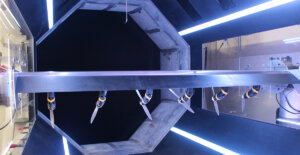
A prototype of a regional/urban mobility aircraft designed by Electra.aero, utilizing distributed electric propulsion and blown lift technology. IMAGE/ELECTRA.AERO.
Researchers continue to look at ways to make aviation more sustainable. However, sustainability in the sky is a challenge that has proven both pressing and formidable, requiring creativity to overcome limitations inherent to defying gravity.
Alejandra Uranga, WiSE Gabilan and USC Viterbi assistant professor of aerospace and mechanical engineering has partnered with start-up company Electra.aero on a new project, funded by NASA, that aims to advance sustainable aviation for urban and regional air markets using electrified aircraft with ultra-short takeoff and landing capabilities. The USC team includes Postdoctoral Associate Saakar Byahut and Ph.D. candidate Tianbo Xie.
For this project, Uranga and Electra are working on blown lift technology, which redirects air to generate a very high lift. This is enabled by distributed electric propulsion, which would allow more flexibility and efficiency for shorter flights. In distributed electric propulsion, electrification also allows for thrust to be generated by an array of smaller propulsors rather than the more typical dual engine configurations.
Said Uranga: “Blown flaps redirect air generated by the propellers over the rear edge of the wings to generate a very high lift and allow the aircraft to take off at very low speeds,” Uranga said. “This would allow planes to take off from spaces like rooftops, parking lots or football fields, without having to use very energy-intensive approaches, like vertical takeoff and landing solutions.”
Marty Bradley, senior technical fellow at Electra.aero and part-time lecturer at USC Viterbi, said: “Electra is very pleased to have teamed with USC to propose and win the Phase I NASA contract. Blown lift technology has been successfully used in the past, including in the ubiquitous C-17 transport plane. What we are doing here is to take it to the next level by applying distributed electric propulsion to spread the blown lift over the entire wing and working to takeoff and land in very short distances, like 100-300 feet. This may enable us to fly in and out of an airfield more the size of a heliport than a traditional airport runway.”
He added, “Generating lift from a wing is much more effective than generating lift directly (like a helicopter does), so the Electra blown lift approach needs much less power for takeoff and landing. This results in better range and payload than for a helicopter or UAM (Urban Air Mobility) air taxi.”
“It’s a technology for urban and regional mobility,” Uranga said. “But it could eventually be used for larger distances. ”

Illustration of blown lift technology. As shown on the right, the flap deflection during takeoff and landing redirects the propeller jet downward and thus generates a very high lift. The flap is retracted during cruse for highly efficient flight. IMAGE/M. Drela.
The Future of Flight: Holistic Solutions and Electrification
A key motivation of this research is integrating solutions to create a more efficient, sustainable aviation system. In the past, Uranga said, individual elements of a system would be optimized in isolation from each other. But what if you looked at the system as a whole and optimized elements in relation to each other instead?
For example, instead of designing an efficient engine in isolation of an efficient airframe, you design them both together, Uranga said. Today’s jet aircraft place the engines away from the airframe’s body to avoid ingestion of the layer of slower flowing air that develops along the aircraft’s surfaces called the boundary layer. A proposed redesign, using boundary layer ingestion, encourages the ingestion of the slower air flow, using it to generate thrust and propel the aircraft more efficiently.
“Another idea is to use electrical components for the propulsion system in order to alleviate reliance on fossil fuels and take advantage of the fact that electrical systems are much more efficient at converting energy into propulsion than jet fuel,” said Uranga. “Part of the challenge with electrification is that you have to redesign the whole aircraft so you can take advantage of the technology. You can’t just replace the propulsion system, mainly because batteries are much heavier than kerosene for a given amount of energy, but also because the added complexity needs to buy its way in.”
“We know, from previous studies from our research group, that high levels of electrification are extremely good for short missions,” Uranga said. Typically, shorter flights (of the order of 100 nautical miles) and a smaller passenger loads (two to 20 people), what are known as thin-haul or commuter missions, see the largest benefits from electrification, she said. “Adding hybrid electric propulsion technologies can be used to extend the ranges to 500 miles or more. We also know that boundary layer ingestion and distributed propulsion enable higher levels of electrification and larger missions.”
Electra.aero already has a relatively mature configuration identified, Uranga said, that takes advantage of distributed electric propulsion to produce blown lift. “We are also helping them to better define the trade-offs and optimize the aircraft,” she said. This work is part of a complementary Electra-funded project.
These are new technologies to meet new demands for urban and regional air mobility. They also offer new opportunities to optimize flying by changing the way we fly—for instance moving away from the hub-and-spoke model and opening up point-to-point flights between regional destinations.
Currently there is no prevailing design for electrification in aviation, Uranga said, largely because optimizing for electrification means different things in different markets. “In order to be more sustainable, you need to move away from ‘one size fits all,’ and so we envision a future where there are a wider variety of vehicles that each serve a specific purpose better,” she said.
Published on July 23rd, 2021
Last updated on July 27th, 2021









